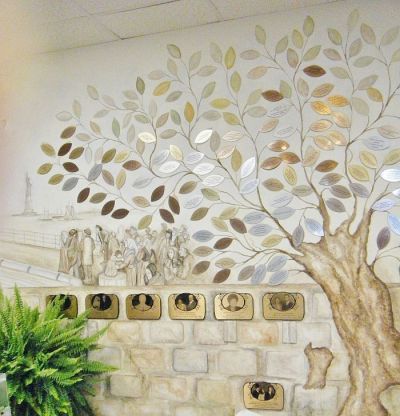Quest’articolo parla del gruppo: American Italian Heritage Association. Nel 1979, il professore Philip DiNuovo invitò un gruppo di professori italiani per discutere come avrebbero potuto mantenere la storia italiana e la loro eredità italiana qui negli stati uniti. La loro missione: conservare la cultura italiana malgrado il fatto che le famiglie italiane non sono più prima o seconda generazioni e non hanno più una connessione profonda alla loro eredità. Quindi, l'associazione si concentra nello studio italiano in una varietà di aspetti. Nel 2004, questo gruppo aprì un museo dedicato alla loro missione. Ci sono memorie e tanti manufatti che aiutano a spiegare la storia gloriosa degli italo-americani. Nel 2014, aprì un altro spazio che include una biblioteca con più di 1.600 libri ed una galleria d’arte.
In 1979, a group of professors met at Syracuse University in New York to discuss their shared interest in how to conserve the history of Italian heritage and culture in America. The meeting was spearheaded by Philip DiNovo, Chairman of the Business Department, and a Professor of Business Administration at a nearby college. Shortly after that meeting, the American Italian Heritage Association was founded “with the expressed purpose of recording and preserving Italian heritage.”
Professor DiNovo became the Association’s first president, and he continues to lead the Association in its mission to sustain the importance of Italian immigrants’ influences and subsequential value in the U.S. In 1985, he established the first museum of Italian American history and culture in Utica, NY, selecting the location because of its large Italian American population. The museum closed when Professor DiNovo retired and moved to Albany, NY in 1998. The entire collection was placed in storage as he made plans to open the museum in a new location.
The plans flourished in 2004, when a former Catholic Church – built in 1922 by Italian immigrants – was purchased as the new site of the American Italian Heritage Museum, currently the largest in the east. It took five years to complete renovations and convert the 4,000-square-foot first floor into 10 exhibit rooms and a gift shop. Each room focuses on a different theme and two rooms are devoted to Italian immigrants, the origins of Italian American history.
Other rooms feature art, Italian folk art, faith, music, sports, vintage photographs, military service, and contributors to America; all filled with artifacts, pictures and murals identifying each aspect of Italian culture in America. A Special Exhibit Room recently featured a display on the artwork of Raphael and showcases various topics throughout the year. In between the rooms, the Hall of History is lined with photographs and posters chronicling the people of Italian heritage who have helped shape the history of America.
I asked Professor DiNovo what inspired him to establish the American Italian Heritage Association and how the artifacts in the museum were collected. He replied “I am a collector. When I went to Italy twice to bring things back, I had a large collection of family artifacts, photos, etc. Many friends, family and members over the years [have] donated items; [and] I picked things up at garage and estate sales.”
Regarding his inspiration: “I read Richard Gambino's book ‘Blood of My Blood.’ It helped me to learn more and value my Italian heritage and culture. It is a great book and very inspiring. He taught at CUNY (City University of New York) in Italian American studies for years and [I] got to meet him.”
Several years before his retirement, Professor DiNovo was awarded the title of Cavaliere in the Order of Merit of the Republic of Italy. The OMRI – the highest honor – is presented to acknowledge the endeavors of individuals in numerous fields, including the arts, public service and humanitarian, social and philanthropic programs.
Does a museum focusing on Italian heritage and culture in America face any particular challenges? Professor DiNovo is contemplative: “The sad thing is that most Italian Americans are assimilated. Our culture does not seem to encourage community and support of institutions. The family has been traditionally the center. We do not have schools to teach young Italian Americans like other ethnic groups. Being Italian means different things to different people. Our challenges are greater because we are not a social group but a cultural group. That has limited appeal. Our mission is to record and preserve our Italian heritage. Our strength is our membership across the nation; our members are committed and support our mission.”
After a five-year renovation – in conforming to building code regulations – in 2014, the Cultural Center opened on the second floor of the former church. The 1,900-square-foot space includes an art gallery, memorial chapel, meeting hall, a classroom, and a library that houses more than 1,600 books. A thrift shop is also located on the property.
A highlight of the museum is the Donor Recognition Tree on the wall opposite the entrance door. The hand-painted trunk in the shape of Italy, leaves of brass, bronze and nickel, and a mural of arriving immigrants with the Statue of Liberty in the background is a fitting tribute not only to Italian immigrants, but also to all those seeking refuge.
During the late 19th and early 20th centuries, as Italian families and townspeople journeyed to a new land, they established communities throughout America, keeping hold of their traditions. Now, Professor DiNovo notes, “it is difficult to get young people to join and today people have many toys to occupy themselves.”
For more about the American Italian Heritage Association, Museum and Cultural Center, visit
https://americanitalianmuseum.org/.



